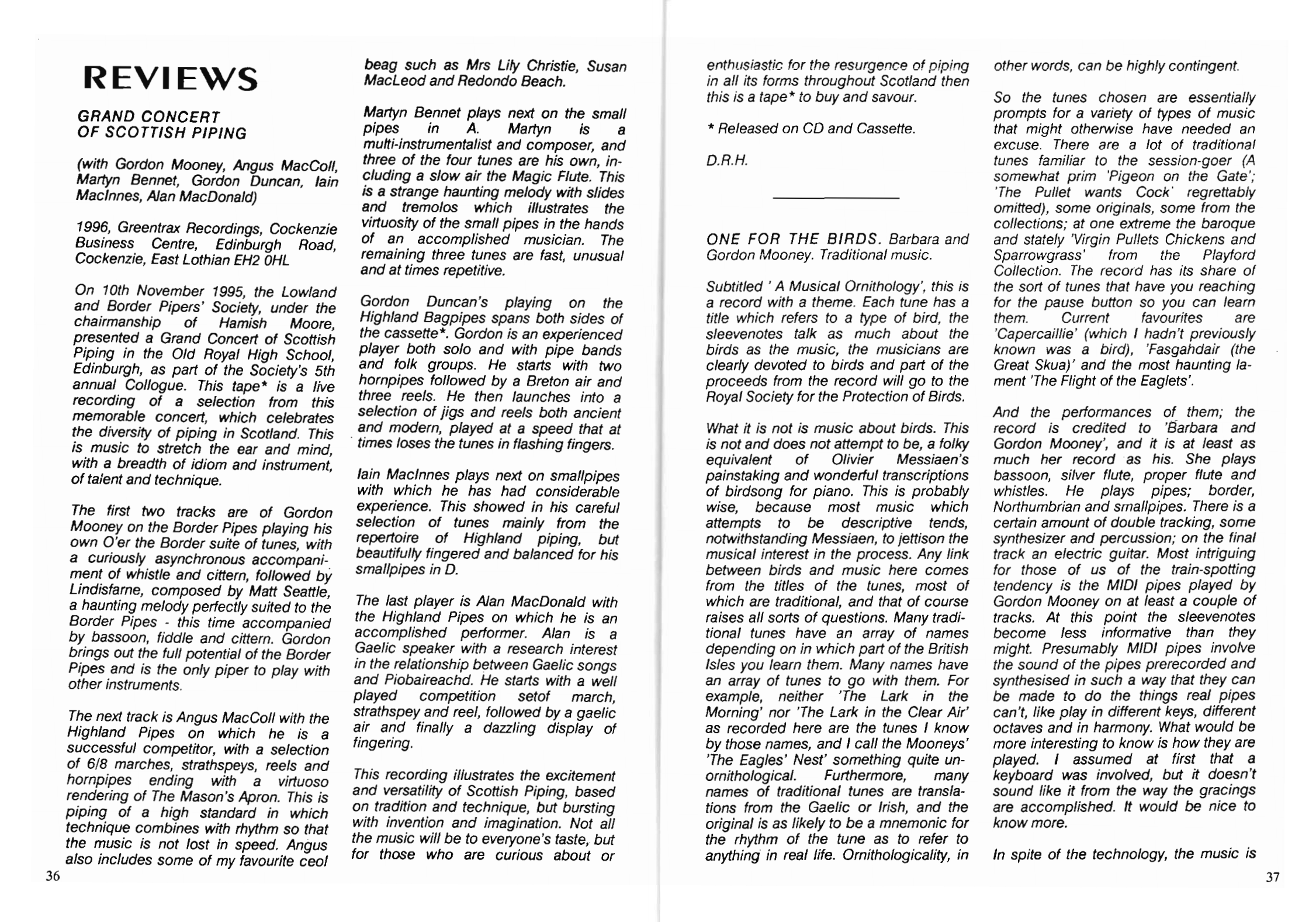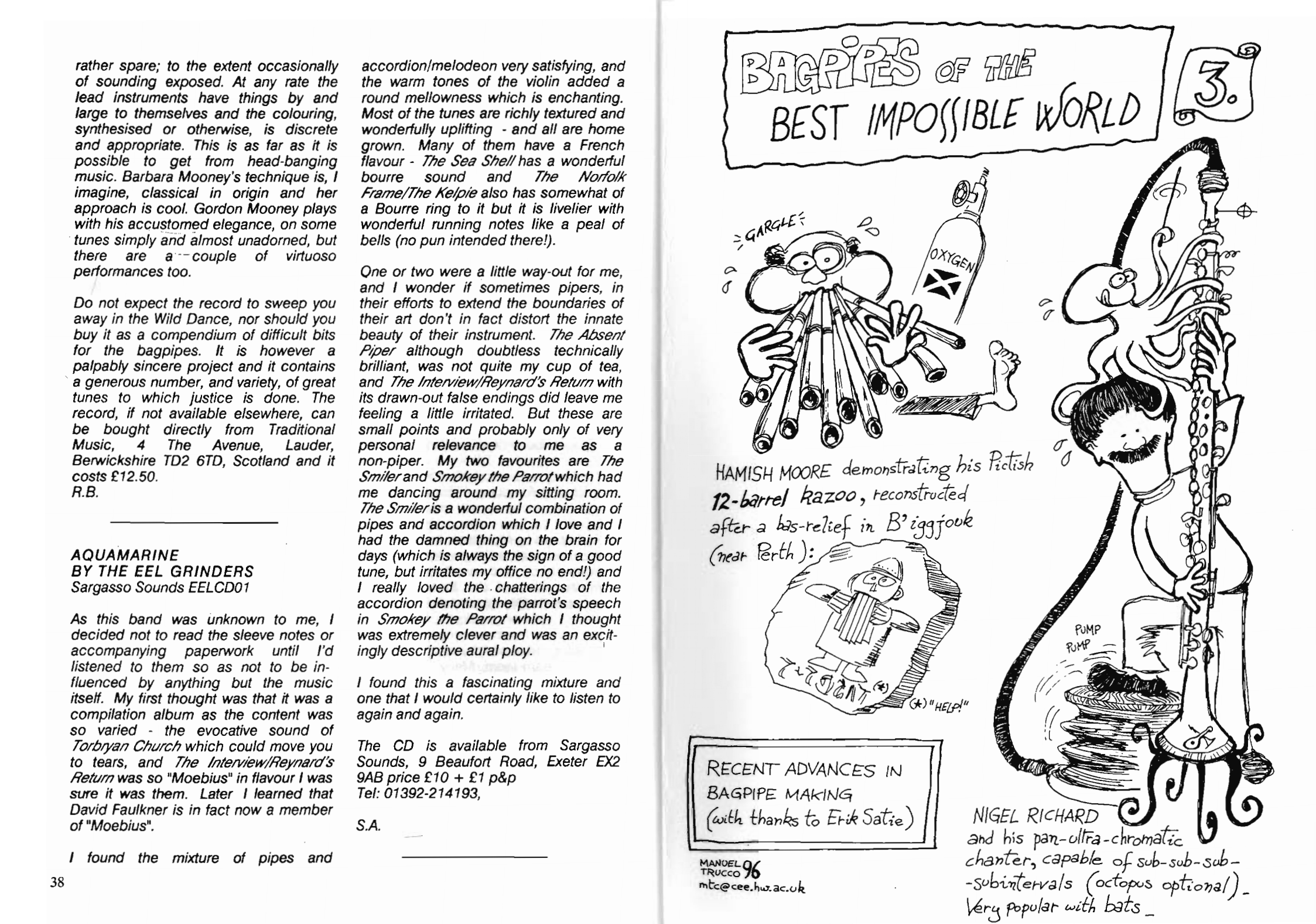Reviews; Grand Concert; One for the Birds; Eel Grinders


GRAND CONCERT OF SCOTTISH PIPING
(with Gordon Mooney, Angus MacColl, Martyn Bennet, Gordon Duncan, Iain Macinnes,
Alan MacDonald)
1996, Greentrax Recordings, Cockenzie Business Centre, Edinburgh Road, Cockenzie, East Lothian EH2 OHL
On 10th November 1995, the Lowland and Border Pipers’ Society, under the Chairmanship of Hamish Moore, presented a Grand Concert of Scottish Piping in the Old Royal High School, Edinburgh, as part of the Society’s 5th annual Collogue. This tape* is a live recording of a selection from this memorable concert, which celebrates the diversity of piping in Scotland. This is music to stretch the ear and mind, with a breadth of idiom and instrument, of talent and technique.
The first two tracks are of Gordon Mooney on the Border Pipes playing his own O’er the Border suite of tunes, with a curiously asynchronous accompaniment of whistle and cittern, followed by Lindisfarne, composed by Matt Seattle, a haunting melody perfectly suited to the Border Pipes - this time accompanied by bassoon, fiddle and cittern. Gordon brings out the full potential of the Border Pipes and is the only piper to play with other instruments.
The next track is Angus MacColl with the Highland Pipes on which he is a successful competitor, with a selection of 6/8 marches, strathspeys, reels and hornpipes ending with a virtuoso rendering of The Mason's Apron. This is piping of a high standard in which technique combines with rhythm so that the music is not lost in speed. Angus also includes some of my favourite ceol beag such as Mrs Lily Christie, Susan MacLeod and Redondo Beach.
Martyn Bennet plays next on the small pipes in A. Martyn is a multi-instrumentalist and composer, and three of the four tunes are his own, including a slow air The Magic Flute. This is a strange haunting melody with slides and tremolos which illustrates the virtuosity of the small pipes in the hands of an accomplished musician. The remaining three tunes are fast, unusual and at times repetitive.
Gordon Duncan’s playing on the Highland Bagpipes spans both sides of the cassette*. Gordon is an experienced player both solo and with pipe bands and folk groups. He starts with two hornpipes followed by a Breton air and three reels. He then launches into a selection of jigs and reels both ancient and modern, played at a speed that at times loses the tunes in flashing fingers.
Iain Macinnes plays next on smallpipes with which he has had considerable experience.
This showed in his careful selection of tunes mainly from the repertoire of Highland piping, but beautifully fingered and balanced for his smallpipes in D.
The last player is Alan MacDonald with the Highland Pipes on which he is an accomplished performer. Alan is a Gaelic speaker with a research interest in the relationship between Gaelic songs and Piobaireachd. He starts with a well played competition set of march, strathspey and reel, followed by a Gaelic air and finally a dazzling display of fingering.
This recording illustrates the excitement and versatility of Scottish Piping, based on tradition and technique, but bursting with invention and imagination. Not all the music will be to everyone’s taste, but for those who are curious about or enthusiastic for the resurgence of piping in all its forms throughout Scotland then this is a tape* to buy and savour.
* Released on CD and Cassette.
D.R.H.
_________________________________________________________________________
ONE FOR THE BIRDS.
Barbara and Gordon Mooney. Traditional music.
Subtitled ‘A Musical Ornithology’, this is a record with a theme. Each tune has a title which refers to a type of bird, the sleevenotes talk as much about the birds as the music, the musicians are clearly devoted to birds and part of the proceeds from the record will go to the Royal Society for the Protection of Birds.
What it is not is music about birds. This is not and does not attempt to be, a folky equivalent of Olivier Messiaen’s painstaking and wonderful transcriptions of birdsong for piano. This is probably wise, because most music which attempts to be descriptive tends, notwithstanding Messiaen, to jettison the musical interest in the process. Any link between birds and music here comes from the titles of the tunes, most of which are traditional, and that of course raises all sorts of questions. Many traditional tunes have an array of names depending on in which part of the British Isles you learn them. Many names have an array of tunes to go with them. For example, neither ‘The Lark in the Morning’ nor ‘The Lark in the Clear Air’ as recorded here are the tunes I know by those names, and I call the Mooneys’ ‘The Eagles’ Nest’ something quite unornithological. Furthermore, many names of traditional tunes are translations from the Gaelic or Irish, and the original is as likely to be a mnemonic for the rhythm of the tune as to refer to anything in real life. Ornithologicality, in other words, can be highly contingent.
So the tunes chosen are essentially prompts for a variety of types of music that might otherwise have needed an excuse. There are a lot of traditional tunes familiar to the session- -goer. (A somewhat prim ‘Pigeon on the Gate’; ‘The Pullet wants Cock’ regrettably omitted), some originals, some from the collections; at one extreme the baroque and stately ‘Virgin Pullets Chickens and Sparrowgrass’ from the Playford Collection. The record has its share of the sort of tunes that have you reaching for the pause button so you can learn them. Current favourites are ‘Capercaillie’ (which I hadn’t previously known was a bird), ‘Fasgahdair (the Great Skua)’ and the most haunting lament ‘The Flight of the Eaglets’.
And the performances of them, the record is credited to “Barbara and Gordon Mooney”, and it is at least as much her record as his. She plays bassoon, silver flute, proper flute and whistles. He plays pipes; Border, Northumbrian and smallpipes. There is a certain amount of double tracking, some synthesizer and percussion; on the final track an electric guitar. Most intriguing for those of us of the train-spotting tendency is the MIDI pipes played by Gordon Mooney on at least 2 couple of tracks. At this point the sleevenotes become less informative than they might. Presumably MIDI pipes involve the sound of the pipes prerecorded and synthesised in such a way that they can be made to do the things real pipes can't, like play in different keys, different octaves and in harmony. What would be more interesting to know is how they are played. I assumed at first that a keyboard was involved, but it doesn't sound like it from the way the gracings are accomplished. It would be nice to know more.
In spite of the technology, the music is rather spare; to the extent occasionally of sounding exposed. At any rate the lead instruments have things by and large to themselves and the colouring, synthesised or otherwise, is discrete and appropriate. This is as far as it is possible to get from head-banging music. Barbara Mooney's technique is, I imagine, classical in origin and her approach is cool. Gordon Mooney plays with his accustomed elegance, on some tunes simply and almost unadorned, but there are a couple of virtuoso performances too.
Do not expect the record to sweep you away in the Wild Dance, nor should you buy it as a compendium of difficult bits for the bagpipes. It is however a palpably sincere project and it contains a generous number, and variety, of great tunes to which justice is done. The record,
if not available elsewhere, can be bought directly from
Traditional Music,
4 The Avenue,
Lauder,
AQUAMARINE
BY THE EEL GRINDERS
Sargasso Sounds EELCDO1
As this band was unknown to me, I decided not to read the sleeve notes or accompanying paperwork until I’d listened to them so as not to be influenced by anything but the music itself. My first thought was that it was a compilation album as the content was so varied - the evocative sound of Torbtyan Church which could move you to tears, and The Interview/Reynard’s Return was so “Moebius” in flavour I was sure it was them. Later I learned that David Faulkner is in fact now a member of “Moebius”.
I found the mixture of pipes and accordion/melodeon very satisfying, and the warm tones of the violin added a round mellowness which is enchanting. Most of the tunes are richly textured and wonderfully uplifting - and all are home grown. Many of them have a French flavour - The Sea Shell has a wonderful bourre sound and The Norfolk Frame/The Kelpie also has somewhat of a Bourre ring to it but it is livelier with wonderful running notes like a peal of bells (no pun intended there!).
One or two were a little way-out for me, and I wonder if sometimes pipers, in their efforts to extend the boundaries of their art don’t in fact distort the innate beauty of their instrument. The Absent Piper although doubtless technically brilliant, was not quite my cup of tea, and The Interview/Reynard’s Return with its drawn-out false endings did leave me feeling a little irritated. But these are small points and probably only of very personal relevance to me as a non-piper. My two favourites are The Smiler and Smokey the Parrot which had me dancing around my sitting room.
The Smiler is a wonderful combination of pipes and accordion which I love and I had the damned thing on the brain for days (which is always the sign of a good tune, but irritates my office no end!) and I really loved the chatterings of the accordion denoting the parrot’s speech in Smokey the Parrot which I thought was extremely clever and was an excitingly descriptive aural ploy.
I found this a fascinating mixture and one that I would certainly like to listen to again and again.
The CD is available from
Sargasso Sounds,
Exeter EX2
9AB price £10 + £1 p&p
Tel: 01392-214193
SA.
